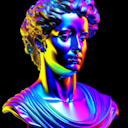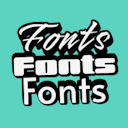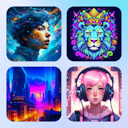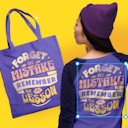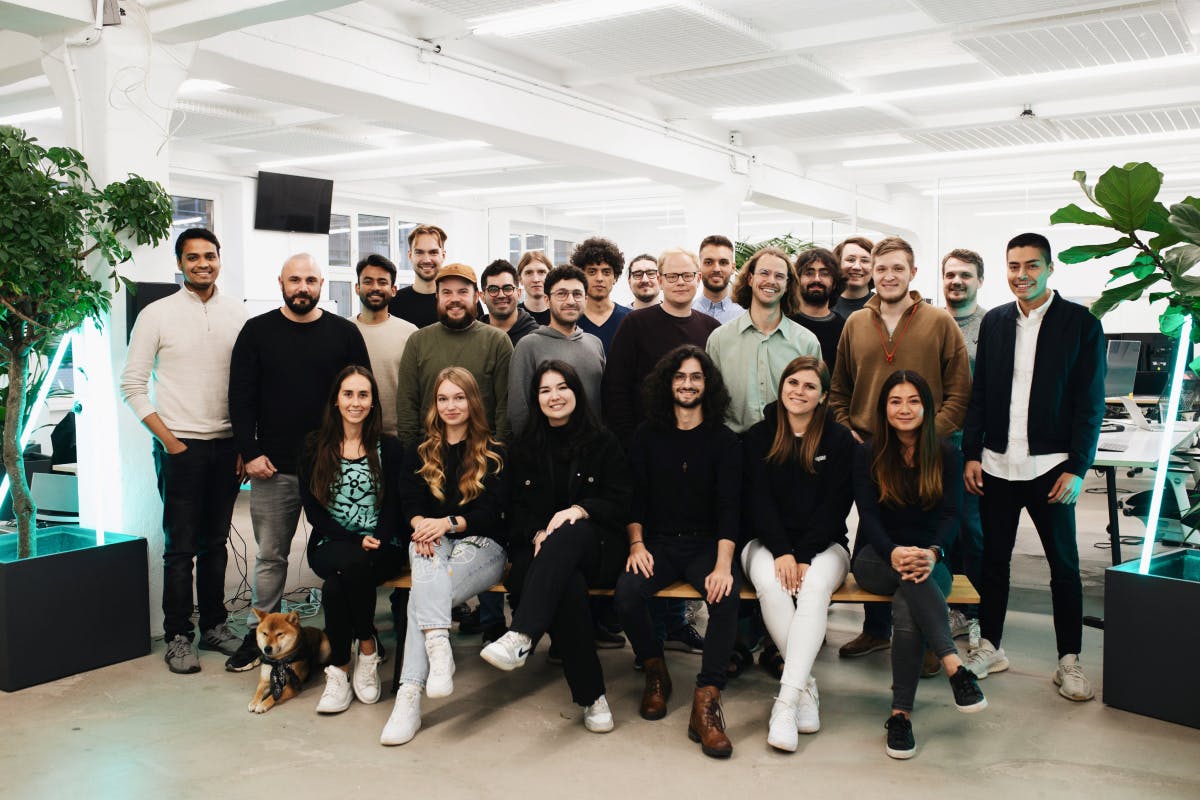Product
Templates
Resources
Company
Home
Blog
Design
Gradient graphic design: How the trend is being used
Gradient graphic design: How the trend is being used

The resurgence of gradient design: But with a twist
In our 2025 graphic design trends report, we predicted the continued rise of gradient graphic design—often referred to as 'aurora' after the aurora borealis (northern lights). And as we move further into the year, that prediction has only solidified.
This colorful design element that first picked up traction in the late '90s has now evolved into a powerful visual tool, embraced by brands, designers, and digital creators alike. But today's gradients aren't just about smooth color transitions—the trend has evolved, integrating new elements like grainy layers and blurs for a dreamy aesthetic.
We’ll explore why this style is making a comeback, how it has evolved, and showcase visual examples of its eight most common uses—from personal projects to professional branding. As a bonus, we’ve shared gradient design templates throughout for download or design inspiration.
Table of contents
What is gradient design?
At its core, gradient design (or aurora design) is the use of blended colors that transition smoothly into one another. Whether that’s a subtle shift from pastel pink to soft orange or a more energetic leap from hot pink to electric purple.
Gradients can take on various forms, including:
- Linear gradients: Color transitions in a straight line.
- Radial gradients: A circular blend, often used for spotlight effects.
- Angular gradients: Color shifts that rotate around a central point.
- Mesh gradients: Complex, multi-directional blends for an artistic effect.

Linear gradient

Radial gradient

Angular gradient

Mesh gradient
What makes today’s gradients stand out is their ability to add mood and movement to designs.
The evolution of gradients: From flat to grainy
After the initial appearance of gradient design in the ‘90s, it made a strong comeback around 2018, adding a smooth and vibrant visual element to design.
Over time, creatives experimented with using gradients in more unconventional ways—layering over photography, used as interactive UI elements, and even bringing them into physical product designs.
Fast-forward to today, and we’ve seen a shift. What’s the main difference? Texture. The latest evolution of gradients embraces a more organic and artistic approach, incorporating:
- Grainy, noise-infused gradients that add an edgy vibe.
- Blurred and dreamy aesthetics for a futuristic, ethereal look.
This shift from sterile, digital gradients to textured, imperfect designs reflects a broader movement in the creative industry—where authenticity, depth, and uniqueness are prioritized over perfection.
Kittl YouTube video exploring the grainy gradient graphic design trend
8 popular use cases for gradient graphic design
From branding and packaging to website design and social media, gradients are everywhere—bringing depth, energy, and lots of color to visuals. No longer just a simple color transition, today’s gradients are thoughtfully used to enhance storytelling, enhance moods, and make designs more engaging.
Whether it’s to convey meaning in brand's visual identity or add a subtle accent in product packaging, gradients continue to evolve and push creative boundaries.
Let’s take a look at eight impactful ways designers are using gradients today.
1. Website UI
Gradients bring websites to life, adding depth and a natural visual flow. When you land on the HomeToGo website, you’re instantly greeted by a beautiful gradient that shifts effortlessly from purple to pink. It’s not just a random design choice—it’s a strategic choice that’s baked into their brand and carried throughout their website and app UI.
This is a great example of a gradient telling a story. The colors don’t just complement each other or stand alone with their own meanings—they blend together to convey a bigger message. In this case, they mirror nature’s color palette, symbolizing a traveler’s journey from sunrise to sunset.
The task was to build a visual concept around the idea of a day in the life of a traveler, mainly associated with the sky’s color gradients in its various manifestations: going from sunrise to sunset, turning into a bright “twilight purple”
”HomeToGo on Behance
2. UI/UX design
Plaid’s rebrand seamlessly integrates gradients into its entire user experience, taking inspiration from the security and craftsmanship of physical currency. Just like holographic strips on banknotes provide both visual appeal and authenticity, Plaid’s gradient-driven UI enhances both aesthetics and usability.
Soft, fluid color transitions capture the eye and guide users naturally through the interface. From interactive elements to background textures, the use of gradients help create a dynamic and fun experience, turning a typically bland subject into something more accessible and interesting.
3. Product packaging
From cosmetics to tech gadgets, gradients have become a go-to tool for brands looking to make their packaging pop on the shelf. These smooth color transitions don’t just add aesthetic value—they establish a mood that aligns with the product, evoking youthful playfulness, sleek sophistication, or an innovative edge.
Gradients can also help differentiate product lines, create visual hierarchy, and draw the eye toward key details like logos or product names.
4. Physical products
Once you start looking, you’ll see gradients everywhere in product design. Phone cases, laptop skins, and notebooks are a few types of products where gradient design is being heavily used, proving how much people love these bold, personalized designs.
And if you pay close attention to social media, you’ll also notice a lot of phone cases with gradient designs. Casetify is the prime example of this with a very large number of gradient phone cases on their site such as the two shown below.

Casetify phone cases with gradient design by jessicapoundstone (left) and Top Girl Studio (right). Images from casetify.com
5. Social media
Gradients aren’t just visually appealing—they’re built for engagement. Whether it’s Instagram carousels or YouTube banners, creators and brands use gradients to stand out in crowded feeds. A well-placed gradient makes social content pop, creating a dynamic first impression that’s especially effective for brands targeting younger audiences in fashion, fitness, and lifestyle spaces.
6. Presentations
Long gone are the days of flat, uninspired slides. Gradients have taken over presentation design, adding a modern, polished look that keeps audiences engaged. Whether it’s a keynote for a product launch, marketing plan presentation or an internal pitch deck, a well-placed gradient can enhance the visual hierarchy and make key information stand out.
Soft, subtle gradients can create a professional and elegant feel, while bold, high-contrast gradients add energy and excitement. Gradient backgrounds are a great choice to create smooth transitions between slides, reinforcing whatever the message is while maintaining a cohesive design.
7. Branding
Gradient design has been an extremely popular choice for visual brand identities. One of the most well-known and recognizable use of gradient design in branding is Instagram.
Their bold, five-color gradient has become a signature look, appearing everywhere from the app’s logo to UI elements like buttons and icons. This design choice isn’t just aesthetic—it reflects the platform’s youthful, vibrant energy while making the interface feel fluid and alive.

The Instagram logo on a phone showing the gradient brand colors. Image from Unsplash in Kittl
8. Marketing materials
Even if gradients aren’t central to a brand’s identity, they’re a powerful tool for marketing. They add vibrancy to everything from digital ads to printed flyers, making designs more attention-grabbing. Whether used subtly or boldly, gradients help marketing materials stand out, creating a sense of depth and movement that draws the eye.
As you can see if you compare the two images below, a gradient transition can be minor (left) for very subtle depth—or more extreme like in the example on the right for bold, sharper contrasts.
Downloadable gradient designs
To help you incorporate modern gradients into your work, we’ve curated a selection of free downloadable gradient designs. These high-quality assets include smooth and grainy gradients, perfect for use in UI design, presentations, product packaging, and more.
Explore these gradients and start integrating them into your creative projects today!
Gradient poster design
Posters are meant to grab attention—and nothing does that quite like a well-crafted gradient. These designs blend bold color transitions with striking compositions, making them perfect for event promotions, branding campaigns, or personal projects.



Learn the exact steps to design these posters in the video tutorial below.
Gradient flyers
A well-placed gradient can transform a flyer from ordinary to eye-catching, using smooth color transitions to draw attention and create a sense of depth.
From subtle color transitions that add depth to content to high-contrast blends that demand attention, gradients can enhance typography, highlight key details, and create a seamless visual flow—turning a simple flyer into a striking piece of design.
Gradient shapes
Gradients don’t just belong in backgrounds—they shine in abstract shapes and graphic elements too. Use them to create dynamic overlays, interactive UI elements, or Zoom backgrounds that make virtual meetings more visually engaging.
In the video below, Graham walks you through how to create and design with grainy, abstract, blurry shapes.
Gradient logo design
A logo is the face of a brand, and gradients add a modern, innovative edge. From tech startups to beauty brands, gradients in logos help create a sleek, professional identity with smooth color transitions.
Gradient banners for YouTube, Soundcloud, and more
Your online presence starts with strong visuals, and a gradient banner makes an instant impact. Whether you're launching a YouTube channel or a SoundCloud profile, these gradient banners add a professional and modern, yet innovative touch.
Key takeaway
Gradient graphic design has evolved from simple color transitions into a powerful visual tool that adds depth, mood, and movement to modern designs. With the rise of grainy textures and blurred effects across branding, UI/UX, and physical products, gradients continue to be a top design trend in 2025.
Whether experimenting with grainy textures, ethereal blurs, or bold color transitions, the future of gradient design is full of possibilities. How will you take this trend to the next level?
Related articles

Design
Classic art: How historical styles are shaping modern trends
Classic art isn’t just hanging in museums anymore—it’s everywhere. From viral memes to period dramas...

Design
Japandi style guide for graphic designers
The Japandi style has been rising rapidly in popularity, blending the simplicity of Japanese minimal...

Design
Doodle art trend: How to create it and where to use it
Doodle art took over the design scene this past year and we’ve predicted it to take off even more in...

